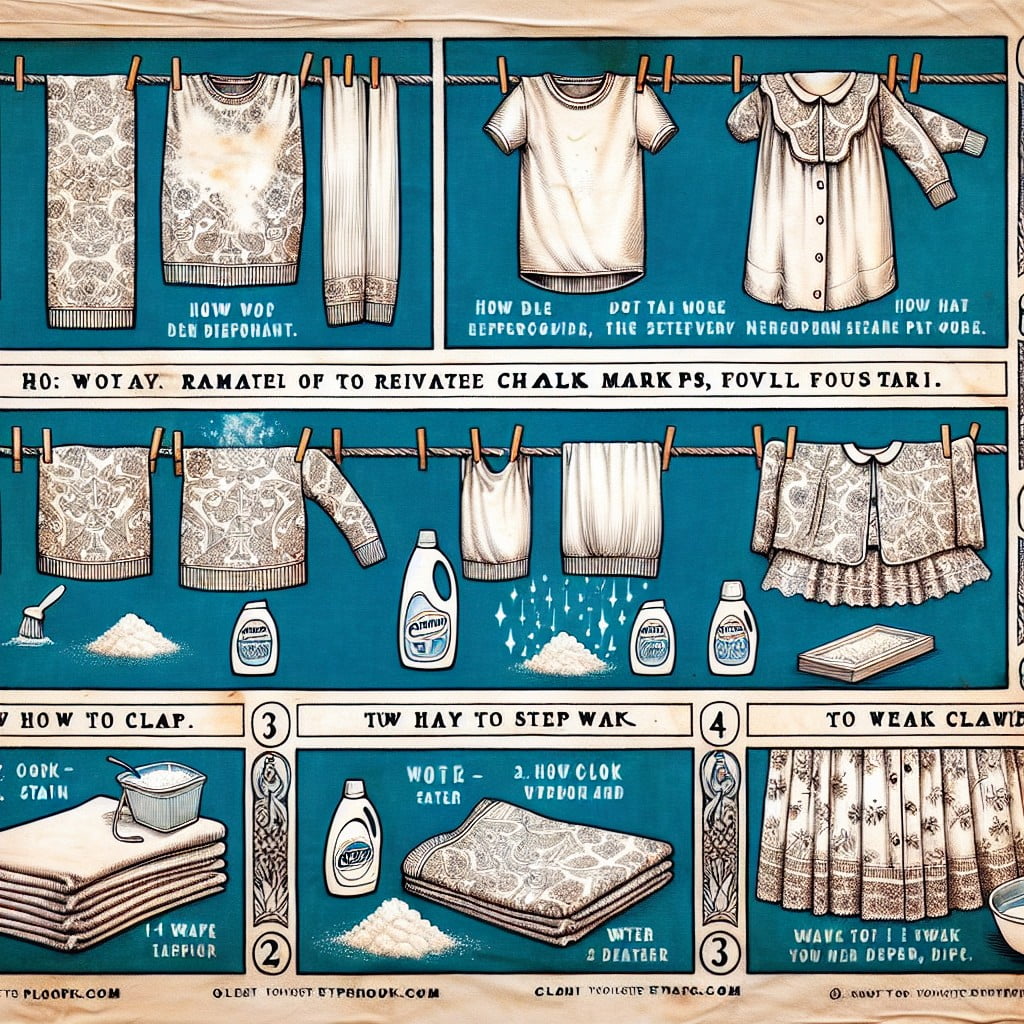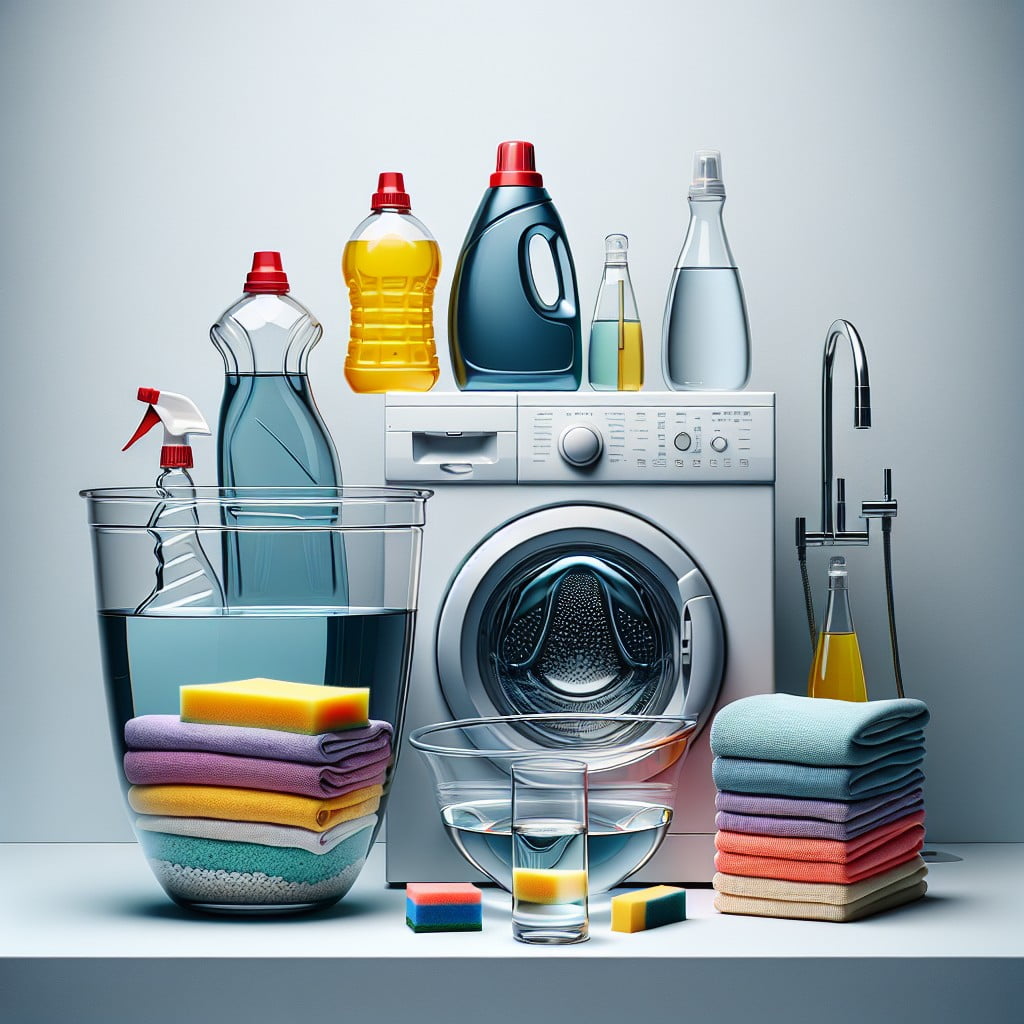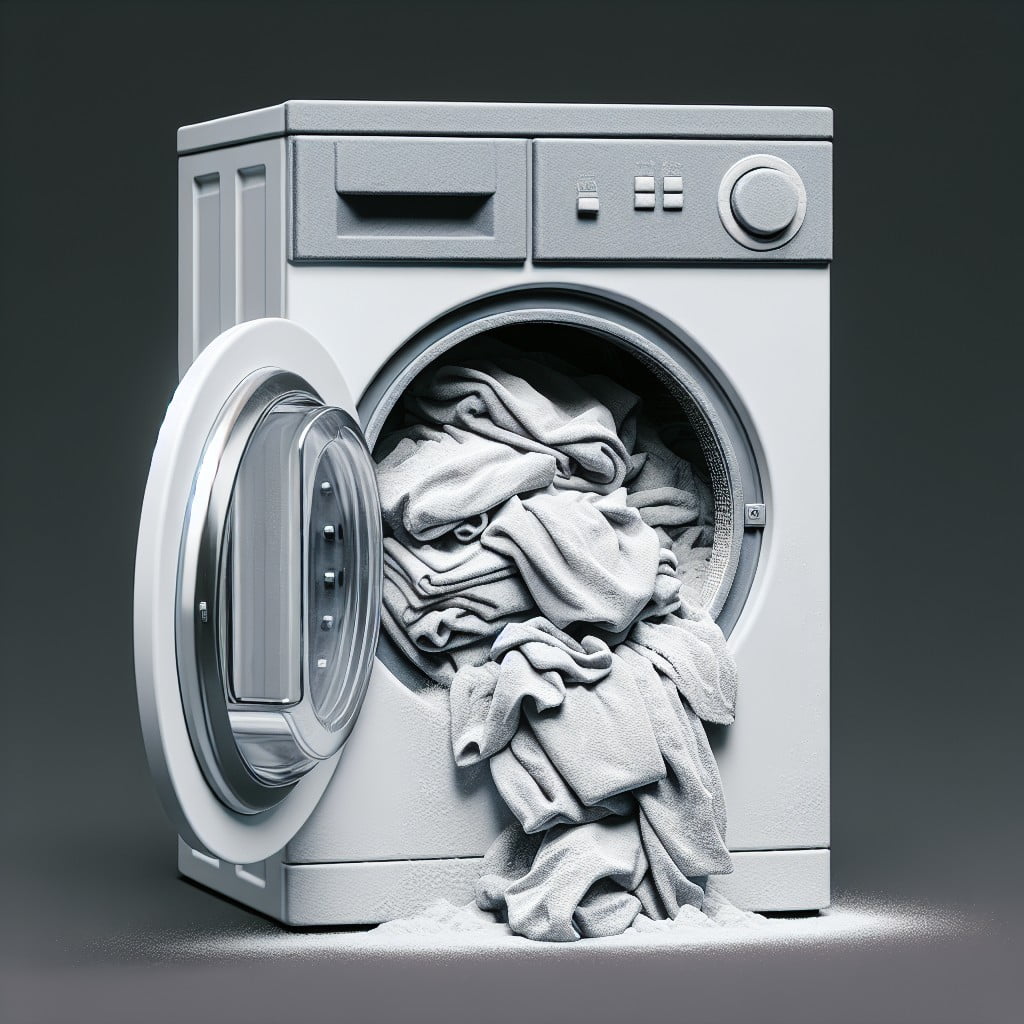Last updated on
In this comprehensive guide, you’ll discover the most effective methods on how to remove chalk from clothes with ease.
Key takeaways:
- Chalk stains can be removed by acting quickly before the chalk gets wet.
- Lukewarm water and mild detergent are usually sufficient for removing fresh chalk stains.
- Tools and ingredients like soft-bristled brushes, mild detergent, white vinegar, and clean cloths can aid in removing chalk stains.
- Machine washing with a heavy-duty laundry detergent and warm water can be effective in removing chalk from clothes.
- Rubbing alcohol or an ammonia solution can be used for more stubborn chalk stains.
Chalk Stain Removal From Clothing And Fabric

Removing chalk from clothes largely relies on the chalk’s composition, which is generally calcium sulfate or calcium carbonate. These substances are not highly pigmented, so they don’t penetrate fabrics deeply, making removal feasible.
When tackling chalk stains, it’s essential to act quickly before the chalk gets wet, which can make the stain more stubborn. Begin by shaking out or gently brushing the affected area to dislodge loose chalk particles. Avoid rubbing the stain, as this could push the chalk deeper into the fibers.
For fresh stains, lukewarm water is usually sufficient to remove the remaining chalk. Gently dab the spot with a clean, damp cloth, working from the outside in to prevent spreading. If water alone doesn’t do the trick, a mild detergent can help. Apply a small amount to the stain and gently rub it with your fingers or a soft brush, then rinse thoroughly.
Effective in most cases, these simple steps can usually lift chalk stains without the need for specialized cleaners or treatments. However, more persistent stains might require additional steps or specific products outlined later in the article.
You Will Need

To effectively combat chalk stains on clothing, have the following items at the ready:
- Soft-bristled brush or clean toothbrush
- Mild liquid laundry detergent
- White vinegar
- Clean white cloth or sponge
- Vacuum with upholstery attachment (if dealing with fabric or upholstery)
- Bucket or bowl for mixing cleaning solutions
- Cold and warm water
- Household ammonia (optional for tougher stains)
These tools and ingredients will assist in pre-treating and washing the affected garments or fabrics, improving the chances of completely removing the chalk without damaging the material.
Steps to Remove the Chalk

Begin by gently brushing off any excess chalk from the fabric surface, using a soft brush or a dry cloth to minimize smearing. Proceed by rinsing the stained area with cold water, flushing out as much chalk dust as possible.
Apply a small amount of liquid laundry detergent or stain remover directly to the mark, and lightly rub it in with your fingers or a soft brush. Let it sit for a few minutes to penetrate and break down the chalk particles.
Rinse thoroughly once again with cold water before placing the garment in the washing machine. If the fabric permits, run a normal wash cycle with warm water and your regular detergent.
After washing, check the stain before drying; if traces remain, repeat the treatment and wash again to avoid setting the stain.
Machine Washing

For machine washing after pre-treating the stain, select a heavy-duty laundry detergent as it contains the necessary enzymes to break down the stain.
Ensure the detergent is properly dispensed to avoid undissolved residues.
Opt for the warm wash cycle as heat helps dissolve chalk compounds, enhancing the stain removal process.
However, be cautious with delicate fabrics that might be sensitive to warm temperatures.
After the cycle, check the garment before placing it in the dryer; heat can set the stain permanently.
If traces of chalk remain, repeat the treatment instead of drying.
For added efficacy, consider adding an oxygen-based bleach compatible with the fabric color and care label instructions to the wash cycle.
This can help lift the stain without damaging the fabric.
How To Remove Chalk Stains From Carpet
Begin by gently scraping away any excess chalk from the carpet fibers using a dull knife or the edge of a credit card, being careful not to spread the chalk dust further. Next, vacuum over the affected area to remove loose particles.
For the next step, mix a small amount of mild dish soap with warm water and lightly dab the solution onto the stain with a clean, white cloth. Blot—don’t rub—the area until the chalk begins to lift. Rinse by blotting with a cloth dampened with plain water to remove any soap residue, as this can attract dirt if left in the carpet.
If the stain persists, create a solution of equal parts white vinegar and water, and apply it to the area with a fresh cloth. This mild acidic solution can help break down the chalk. Blot gently and rinse with water as above.
Once you’re satisfied that the stain is gone or significantly diminished, blot the area with a dry towel to absorb any remaining moisture. Allow the carpet to air dry completely. If needed, vacuum once more to restore the carpet’s pile.
Stubborn Stains
When tackling more tenacious chalk marks, common household items like rubbing alcohol or an ammonia solution can be effective.
Dip a cotton ball in rubbing alcohol and dab the stained area before laundering. This can break down the chalk’s grip on the fabric fibers.
If the stain persists, mix one tablespoon of ammonia with half a cup of warm water. Apply this mixture with a sponge, working from the outside of the stain inward, to prevent spreading.
After treating with alcohol or ammonia, rinse the fabric thoroughly with water, and then proceed to wash as usual.
Remember to always spot test any chemical on a small, inconspicuous area, as both alcohol and ammonia may alter some fabric colors or textures.
Alcohol
For more stubborn chalk stains, rubbing alcohol can be an effective treatment. Apply a small amount directly onto the mark and gently blot with a clean cloth. The alcohol breaks down the chalk’s pigments, making it easier to lift from the fibers.
Here are the key steps to use this method:
- Test an inconspicuous area of the fabric first to ensure the alcohol won’t cause discoloration.
- Dab the stain with a cotton ball soaked in rubbing alcohol; avoid rubbing, as this can spread the chalk.
- Let the solution sit for a few minutes to penetrate the stain.
- Blot with a clean dry cloth until the stain is no longer transferring.
- Once the area is stain-free, rinse with cold water to remove any alcohol residue.
- Wash according to the garment’s care label instructions.
Using this technique, you can address the stain without the need for harsh chemicals or extensive scrubbing, preserving the integrity of your clothing.
Ammonia Solution
For more persistent chalk stains, a diluted ammonia solution can work wonders. To create the solution, mix one tablespoon of ammonia with half a cup of warm water.
Before applying, test the ammonia mixture on a small, inconspicuous area of the fabric to ensure colorfastness. If the fabric’s color remains unchanged, dab the solution onto the stain using a clean, white cloth. Gently work it into the fabric without rubbing too hard to prevent the stain from spreading.
After treating the stain, rinse the area thoroughly with clean water. Remember that ammonia has a strong odor and should be used in a well-ventilated area. Additionally, never mix ammonia with bleach, as this combination produces toxic fumes.
Laundry Tips
When tackling chalk stains in your laundry, consider these helpful tips to enhance the cleaning process:
1. Pre-treat Immediately: As soon as you notice a chalk mark on your clothing, act swiftly. The longer it sits, the harder it will be to remove.
2. Test For Colorfastness: If you’re using any stain remover for the first time, apply a small amount on a hidden section of the fabric to ensure it doesn’t cause discoloration.
3. Avoid Heat: Heat can set stains, making them permanent, so always use cold water when dealing with chalk.
4. Gentle Detergent: Select a gentle detergent that’s less likely to damage fabric fibers while loosening the chalk particles.
5. Soft-Bristled Brush: A brush can help work out the chalk dust from the fibers. Use light strokes to prevent damaging the fabric.
6. Repeat if Needed: Sometimes, one wash isn’t enough. If the stain persists, repeat the pretreatment and washing cycle before drying.
7. Air-Dry: Air-drying gives you the chance to check if the stain is completely gone and avoid setting it with the high heat of a dryer.
Pre-treatment Techniques
Before tossing chalk-stained items into the wash, a few preparatory steps can increase your chances of success:
- Gently brush off any loose chalk particles from the fabric surface using a soft-bristled brush to prevent the stain from spreading.
- Apply a stain remover or a small amount of liquid laundry detergent directly onto the mark. Massage it in gently with your fingers or a soft cloth, allowing the product to penetrate the fibers.
- Let the garment sit with the pre-treatment for at least 5-10 minutes. For more stubborn stains, extending this time can improve the effects.
- Dabbing, rather than rubbing, is key to lifting the chalk out—rubbing might drive the chalk particles deeper into the material.
- Before moving on to machine washing, ensure the pre-treatment doesn’t discolor the fabric by testing it on a small, inconspicuous area first.
Temperature Settings for Washing Chalk-Stained Clothes
When dealing with chalk stains, the right temperature setting on your washing machine can make a significant difference. Cold water is generally best for chalk-stained clothing as it can prevent the stain from setting further. Hot water may cause the chalk to dissolve more readily, but it can also set certain types of chalk stains, making them harder to remove. Always check the care label on your garment for the recommended water temperature and, if in doubt, opt for a cooler setting.
A pre-soak in cold water might loosen the chalk particles before the wash cycle. For the wash cycle, if the fabric is durable and the care label permits, you could use warm water to help dissolve the chalk. For delicates or when the care label advises against it, stick to cold wash settings. If the stain persists after washing, do not place the item in the dryer as the heat can permanently set the stain. Instead, allow it to air dry and then treat it again if needed.
Stain Removal Basics
Act promptly; the sooner you address a chalk stain, the easier it will be to remove.
Blot, don’t rub; to avoid pushing the chalk deeper into the fabric fibers, gently blot the affected area.
Use cold water; hot water can set the stain, making it more difficult to remove.
Utilize a stain remover suitable for the type of fabric you’re dealing with, following product instructions closely.
Always test any stain removal technique on a small, inconspicuous area first to ensure it doesn’t damage the fabric color or texture.
Avoid using bleach directly on chalk stains; it may react with the chalk and make the stain harder to remove.
Consider repeating the treatment; some stains may need a second or even third application for complete removal.
Removing Stains From Chalk From Upholstery
Begin by gently scraping away any excess chalk with a dull knife or edge, taking care not to spread the chalk further or damage the fabric.
Next, dab the stained area with a clean cloth dampened with warm water to help lift the chalk.
If warm water alone doesn’t do the trick, mix a small amount of mild dish soap in the water and apply it to the stain using a sponge or soft brush in a light circular motion.
Blot dry with a towel, then let the upholstery air dry completely.
If the chalk is still visible, repeat the process until the stain is fully removed.
Remember to test any cleaning solution on an inconspicuous area first to ensure colorfastness and prevent potential damage to your upholstery.
Step One – Scrape It
Begin by gently removing as much excess chalk as possible. A blunt tool, like the back of a butter knife or a credit card, allows you to scrape off the chalk without damaging the fabric. It’s important to use light strokes to avoid embedding the chalk deeper into the material.
As you scrape, do it over a trash bin or a piece of paper to catch the chalk dust, which makes for an easier cleanup. If the fabric is delicate, consider simply shaking it out or using a soft brush to lightly dust off the chalk.
Step Two – Warm Water
Having carefully scraped away excess chalk, it’s time to utilize warm water to further loosen the chalk particles from the fabric fibers. Warm water helps to dissolve the chalk dust, making it easier to lift from the material.
- Test fabric resistance to warm water on an inconspicuous area to ensure colorfastness and prevent damage.
- Dampen a clean, soft cloth with warm water. The warmth will aid in breaking down the chalk’s grip on the fabric.
- Blot the stain gently. Rubbing can work the chalk deeper into the material, so a soft touch is key.
- Reapply with a fresh section of the damp cloth as needed, ensuring that the stain is effectively thinned without spreading.
Remember that warmth is crucial in this step, as cold water may not be as effective in dissolving the chalk particles.
FAQ
Does chalk come out of clothes easily?
Yes, chalk can be effectively removed from clothes by applying certain treatments and washing methods.
Does chalk wash away?
Yes, chalk typically washes away with water, particularly from paved or poured surfaces that are more than two years old.
Does chalk line come out of clothes?
Yes, chalk line can be removed from clothes through a thorough washing process.
What types of chalk are more difficult to remove from clothing?
Oil-based chalks are more difficult to remove from clothing.
Can different fabric materials affect the ease of chalk removal?
Yes, different fabric materials can significantly affect the ease of chalk removal.
How do various laundry detergents perform in removing chalk stains?
Laundry detergents vary in performance when it comes to chalk stain removal, with some like Tide Plus Downy and Persil ProClean demonstrating superior efficacy due to their enzyme-based formulas.
Recap:




